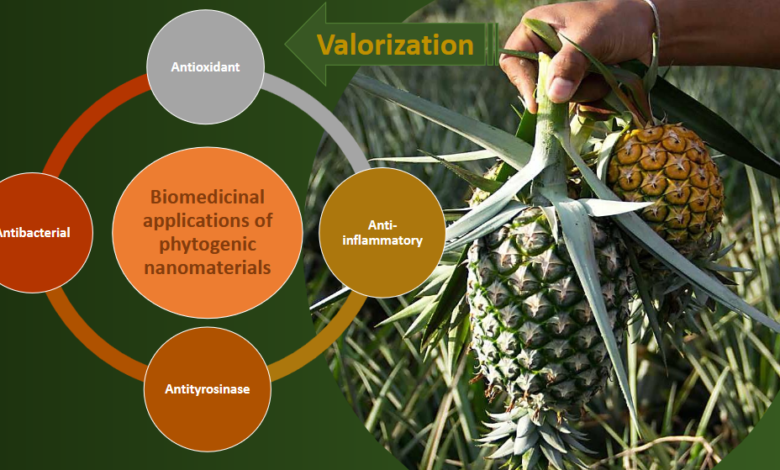Tiny Tech, Big Impact: Nanotechnology Breathes New Life into Pineapple Agricultural Waste
Samudrika Aththanayaka, M.Phil. Research Candidate, Department of Biochemistry, Faculty of Medical Sciences, University of Sri Jayewardenepura

The inadequate management of agricultural waste leads to environmental pollution and health risks. Green nanotechnology offers a solution by repurposing agro-waste into valuable products. This study focuses on two popular Sri Lankan pineapple varieties, Murusi and Kew, revealing significant phytochemical constituents in their waste parts (peels, crowns, and leaves). These typically discarded components can be utilized for eco-friendly synthesis of metal and metal oxide nanoparticles/nanocomposites. The biosynthesized nanomaterials exhibit outstanding biological activities, including antioxidant, anti-inflammatory, antityrosinase, and antibacterial properties. These activities are attributed to the synergistic effect of primary and secondary metabolites in the pineapple waste. The plant extract-mediated nanomaterials show superior biological activities compared to conventional synthesis methods. The study also highlights the influence of nanomaterial properties, such as particle size, morphology, and crystalline structure, on their biological activities. This sustainable approach to valorizing pineapple agro-waste presents promising applications in biomedicine.
Keywords: pineapple agro-waste, valorization, green nanotechnology, biological activity, sustainability
Content
Ananas comosus, commonly known as pineapple, is a versatile tropical plant belonging to the Bromeliaceae family. With approximately 30 cultivars worldwide, pineapples are classified into four main commercial groups: Red Spanish, Pernambuco, Queen, and Smooth Cayenne (Hikal, Mahmoud, Ahl, et al., 2021). This adaptable plant thrives in diverse environmental conditions, making it a significant crop in tropical regions. Sri Lanka, for instance, primarily cultivates Smooth Cayenne and Mauritius varieties.
Currently, pineapple is produced in almost every corner of the world, and its multiple uses, especially its biological importance, have made it incredibly well-known worldwide. Global annual production reaches 24.8 million tons, but 55% becomes waste during processing (Suleria et al., 2020). These discarded parts contain valuable bioactive compounds, varying among species and cultivars due to factors like climate and soil. The plant’s adaptability and nutritional value make it a significant crop in tropical regions, with potential for further utilization of its byproducts.
Composition and Biochemical Profile:
Pineapple fruit is predominantly composed of water (81-86%), with the remaining solid portion consisting mostly of carbohydrates (85%) and other essential nutrients (15%). This tropical fruit is a rich source of potassium, calcium, vitamin C, copper, folate, glycans, and fiber while being low in fat and sodium (Hikal, Mahmoud, Ahl, et al., 2021; Das et al., 2019). One of its most significant components is bromelain, a protein extract containing proteolytic enzymes with various medicinal properties (Ajayi et al., 2022).
Recent studies on pineapple agro-waste (peels, crowns, leaves) have revealed a significant presence of carbohydrates, proteins, phenols, tannins, and flavonoids in aqueous extracts. Fourier-transform infrared (FTIR) spectroscopy analysis of plant extracts identified primary and secondary metabolites, including hydroxyl, aldehyde, ketone, amine, thiol, and ester groups. This complex biochemical profile highlights the potential of pineapple agro-waste for various applications beyond its traditional use as a nutritious fruit.
Green Synthesis of Nanoparticles:
The rich phytochemical profile of pineapple agro-waste presents an opportunity for the green synthesis of metal and metal oxide nanoparticles (NMs). This sustainable approach influences the reducing, capping, and stabilizing properties of plant metabolites to synthesize phytogenic NMs with exceptional properties for various applications (Hulkoti and Taranath, 2014; Sharma et al., 2019).
In this study, we explored the synthesis of silver/silver oxide (Ag/Ag2O) nanoparticles (NPs), zinc oxide (ZnO) NPs, and silver/silver oxide/zinc oxide (Ag/Ag2O/ZnO) nanocomposites (NCs) using pineapple peel, crown, and leaf extracts separately. The synthesis process was optimized under various conditions, including ion precursor concentrations, mixing ratios of plant extract to metal ion solutions, irradiation methods (solar, microwave, UV), pH, and incubation time.
For Ag/Ag2O NPs, different AgNO3 concentrations and irradiation methods were tested, while ZnO NPs were synthesized using Zn[CH3(COO)]2.2H2O as a precursor, with microwave irradiation yielding the best results. ZnO NP synthesis was optimized at pH 12 and a 24-hour incubation time was the best incubation time for the synthesis of NMs. These optimized conditions of individual NPs synthesis were then used to synthesize Ag/Ag2O/ZnO NCs. The biologically synthesized NMs were subsequently evaluated for various biological activities and compared with their respective plant extracts, demonstrating the potential of pineapple agro-waste in sustainable nanotechnology applications.
Characterization of Nanomaterials:
The formation of agro-waste-mediated Ag/Ag2O NPs, ZnO NPs, and Ag/Ag2O/ZnO NCs was initially confirmed through their characteristic surface plasmon resonance peaks. FTIR analysis revealed the role of plant metabolites as reducing, capping, and stabilizing agents in the synthesis of NMs. Scanning electron microscopy (SEM) and transmission electron microscopy (TEM) analyses elucidated the morphologies and sizes of the synthesized NMs. Ag/Ag2O NPs exhibited spherical shapes with sizes ranging from 5-15 nm. ZnO NPs displayed nanoflower and nanoflakes-shaped structures with sizes between 15-124 nm. The Ag/Ag2O/ZnO NCs showed a combination of morphologies, with spherical Ag/Ag2O particles deposited on the surface of ZnO structures, ranging in size from 11-19 nm. X-ray diffraction (XRD) analysis verified the crystalline structures of the biogenic NMs. Ag and Ag2O exhibited face-centered cubic structures, while ZnO displayed a wurtzite hexagonal structure. Both crystalline structures were clearly identifiable in the NCs.
Biological Activities:
The biological activities of the phytogenic NMs including antioxidant, anti-inflammatory, antityrosinase, and antibacterial activities were evaluated and compared with reference standards and their respective plant extracts. The results demonstrated that Ag/Ag2O NPs exhibited superior anti-inflammatory, antityrosinase, and antibacterial properties. This enhanced activity was attributed to their smaller particle sizes and spherical morphology, which likely increased their surface area and reactivity.
Interestingly, Ag/Ag2O/ZnO NCs showed the highest antioxidant activity among the synthesized NMs. This observation was attributed to the synergistic effect of both NPs and the antioxidant- rich plant material. The combination of different nanostructures and residual phytochemicals appeared to boost the overall antioxidant capacity of the NCs. ZnO NPs exhibited lower biological activity compared to other NMs. This reduced activity was likely due to their larger particle sizes and nanoflower/nanoflake morphologies, which may have limited their surface area and reactivity.
Antibacterial assays were conducted against Escherichia coli (gram-negative) and Staphylococcus aureus (gram-positive) to evaluate the antimicrobial potential of the synthesized NMs. The results demonstrated effective growth inhibition of both gram-positive and gram- negative bacteria by the NMs. Notably, Ag/Ag2O NPs exhibited outstanding growth inhibition compared to other NMs. This superior antibacterial activity was attributed to their spherical shape and smaller particle sizes, which likely facilitated better interaction with bacterial cell membranes and enhanced penetration into bacterial cells.
While the synthesized NMs exhibited lower biological activities compared to reference standards, they significantly outperformed their respective plant extracts. This enhancement in activity highlights the potential of nanoparticle synthesis as a method to concentrate and amplify the biological properties of pineapple agro-waste.
Importance and Future Prospects:
This study underscores the significant potential of pineapple agro-waste-mediated NMs for various biological applications. The green synthesis approach offers several advantages over conventional methods, including eco-friendliness, biocompatibility, and cost-effectiveness. By transforming agricultural waste into valuable nanomaterials with significant biological activities,
this research not only addresses environmental concerns but also opens up new avenues for economic development.
The substantial biological activities observed in these phytogenic NMs, particularly their anti- inflammatory, antityrosinase, antioxidant, and antibacterial properties, highlight their potential for diverse biomedical applications. The superior performance of Ag/Ag2O NPs in antibacterial assays against both gram-positive and gram-negative bacteria is especially noteworthy, suggesting possible applications in antimicrobial treatments or wound healing. Moreover, this study presents a sustainable approach to valorizing agricultural waste in Sri Lanka, offering a promising pathway for the effective utilization of pineapple byproducts in various industries. The findings pave the way for future research into optimizing these green synthesis methods and exploring broader applications of these nanomaterials in fields such as medicine, agriculture, and environmental remediation.
In conclusion, this research demonstrates a viable method for synthesizing biologically active NMs from pineapple agro-waste while simultaneously addressing waste management issues. By utilizing pineapple agro-waste for the synthesis of biologically active nanoparticles, we not only add value to agricultural byproducts but also contribute to the development of sustainable and eco-friendly nanomaterials. Future research should focus on further optimizing the synthesis conditions, exploring the mechanisms behind the observed biological activities, and investigating potential applications in various fields. Additionally, scaling up the production process and conducting in vivo studies will be crucial steps towards the practical application of these nanoparticles in biomedical and industrial settings. This research marks a significant step towards the sustainable utilization of agricultural waste and the development of green nanotechnology, opening up new possibilities for the valorization of pineapple agro-waste and potentially other agricultural byproducts.
References
Ajayi, A. M., Coker, A. I., Oyebanjo, O. T., Adebanjo, I. M., & Ademowo, O. G. (2022). Ananas comosus (L) Merrill (pineapple) fruit peel extract demonstrates antimalarial, anti- nociceptive and anti-inflammatory activities in experimental models. Journal of Ethnopharmacology, 282(April 2021), 114576. https://doi.org/10.1016/j.jep.2021.114576.
Das, G., Patra, J. K., Debnath, T., Ansari, A., & Shin, H. S. (2019). Investigation of antioxidant, antibacterial, antidiabetic, and cytotoxicity potential of silver nanoparticles synthesized using the outer peel extract of Ananas comosus (L.). PLoS ONE, 14(8), 1–19.
https://doi.org/10.1371/journal.pone.0220950.
Hikal, W. M., Mahmoud, A. A., Ahl, H. A. H. S., & Bratovcic, A. (2021). Pineapple ( Ananas comosus L . Merr .), Waste Streams , Characterisation and Valorisation : An Overview.
September. https://doi.org/10.4236/oje.2021.119039.
Hulkoti, N. I., & Taranath, T. C. (2014). Biosynthesis of nanoparticles using microbes— A review. Colloids and Surfaces B: Biointerfaces, 121, 474–483.
https://doi.org/10.1016/j.colsurfb.2014.05.027.
Sharma, D., Kanchi, S., & Bisetty, K. (2019). Biogenic synthesis of nanoparticles: A review. Arabian Journal of Chemistry, 12(8), 3576–3600. https://doi.org/10.1016/j.arabjc.2015.11.002.
Suleria, H. A. R., Barrow, C. J., & Dunshea, F. R. (2020). Screening and characterization of phenolic compounds and their antioxidant capacity in different fruit peels. Foods, 9(9).
https://doi.org/10.3390/foods9091206.

Samudrika Aththanayaka,
M.Phil. Research Candidate,
Department of Biochemistry, Faculty of Medical Sciences,
University of Sri Jayewardenepura

